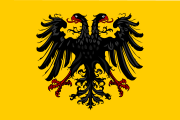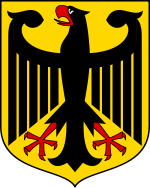Charles V, Holy Roman Emperor
|
||||||||||||||||||||||||||||||||||||||||||||||||||
|
||||||||||||||||||||||||||||||||||||||||||||||||||
Charles V (24 February 1500 – 21 September 1558) was ruler of the Holy Roman Empire from 1519 and, as Charles I of Spain, of the Spanish realms from 1516 until his abdication in 1556. On the eve of his death in 1558, his realm, which has been described as one in which the sun never sets, spanned almost 4 million square kilometers.
As the heir of four of Europe's leading dynasties – the Habsburgs of Austria, the Valois of Burgundy, the Trastamara of Castile and the House of Aragon – he ruled over extensive domains in Central, Western and Southern Europe, as well as the various Castilian (Spanish) colonies in the Americas.
He was the son of Philip I of Castile (Philip the Handsome) and Juana of Castile (Joanna the Mad of Castile). His paternal grandparents were the Holy Roman Emperor Maximilian I and Mary of Burgundy, whose daughter Margaret raised him. His maternal grandparents were Ferdinand II of Aragon and Isabella I of Castile, whose marriage had first united their territories into what is now modern Spain, and whose daughter Catherine of Aragon was Queen of England and first wife of Henry VIII. His cousin was Mary I of England, who married his son Philip.
Charles' reign constitutes the pinnacle of Habsburg power, when all the family's far flung holdings were united in one hand. After his reign, the realms were split between his descendants, who received the Spanish possession and the Netherlands, and those of his younger brother, who received Austria, Bohemia and Hungary.
Aside from this, Charles is best known for his role in the Protestant Reformation[1] and the convocation of the Council of Trent.
Contents |
Heritage and early life
Combining the heritage of the German Habsburgs, the House of Burgundy, and the Spanish heritage of his mother, Charles transcended ethnic and national boundaries. His motto was Plus Ultra, Further Beyond, and it became the national motto of Spain.
Charles was born in the Flemish city of Ghent in 1500. The culture and courtly life of the Burgundian Low Countries were an important influence in his early life. He spoke five different languages: Dutch, German, Spanish, French, and Italian. He spoke French as his mother language and Dutch (Flemish) from his childhood years, later adding an acceptable Spanish (which was required by the Castilian Cortes as a condition for becoming king of Castile) and some German. [2] Indeed, he has been attributed with saying "I speak Spanish to God, Italian to women, French to men, and German to my horse."[3]
From his Burgundian ancestors, he inherited an ambiguous relationship with the Kings of France. Charles shared with France his mother tongue (together with Dutch) and many cultural forms. In his youth, he made frequent visits to Paris, then the largest city of Western Europe.
In his words: "Paris is not a city, but a universe" (Lutetia non urbs, sed orbis). But Charles also inherited the tradition of political and dynastical enmity between the Royal and the Burgundian lines of the Valois Dynasty. This conflict was amplified by his accession to both the Holy Roman Empire and the kingdom of Spain.
Though Spain was the core of his kingdom, he was never totally assimilated and especially in his earlier years felt like and was viewed as a foreign prince. He could not speak Spanish very well, as it was not his primary language. Nonetheless, he spent most of his life in Spain, including his final years in a Spanish monastery.
Marriage and children
On 10 March 1526, Charles married his first cousin Isabella of Portugal, sister of John III of Portugal.
Their children included:
- Philip II of Spain (1527 - 1598), the only son to reach adulthood.
- Maria of Spain (1528 - 1603), who married her first cousin Maximilian II, Holy Roman Emperor.
- Joan of Spain (1535 - 1573), who married her first cousin Infante John of Portugal, who was the heir of Portugal.
Charles also had several mistresses (courted them before and after his marriage to Isabella). Two of them gave birth to two future Governors of the Habsburg Netherlands:
- Johanna Maria van der Gheynst, a servant of Charles de Lalaing, Seigneur de Montigny, daughter of Gilles Johann van der Gheynst and wife Johanna van der Caye van Cocambi, Flemings, bore Margaret of Parma and
- Barbara Blomberg bore John of Austria.
Reign

Burgundy and the Low Countries
In 1506, Charles inherited his father's Burgundian territories, most notably the Low Countries and Franche-Comté, most of which were fiefs of the German empire, except his birthplace of Flanders that was still a French fief, a last remnant of what had been a powerful player in the Hundred Years' War. As he was a minor, his aunt Margaret acted as regent until 1515 and soon she found herself at war with France over the question of Charles' requirement to pay homage to the French king for Flanders, as his father had done. The outcome was that France relinquished its ancient claim on Flanders in 1528.
From 1515 to 1523, Charles' government in the Netherlands also had to contend with the rebellion of Frisian peasants (led by Pier Gerlofs Donia and Wijard Jelckama). The rebels were initially successful but after series of defeats, the remaining leaders were captured and decapitated in 1523.
Charles extended the Burgundian territory with the annexation of Tournai, Artois, Utrecht, Groningen and Guelders. The Seventeen Provinces had been unified by Charles' Burgundian ancestors, but nominally were fiefs of either France or the Holy Roman Empire. In 1549, Charles issued a Pragmatic Sanction, declaring the Low Countries to be a unified entity of which his family would be the heirs.[2]
The Low Countries held an important place in the Empire. For Charles V personally, they were the region where he spent his childhood. Because of trade and industry and the rich cities, they were also important for the treasury.
Spain

In the Castilian Cortes of Valladolid of 1506, and of Madrid of 1510 he was sworn as prince of Asturias, heir of his mother the queen Joanna.[4]. On the other hand, in 1502, the Aragonese Cortes gathered in Saragossa, alleged oath to his mother Joanna as heiress, but the Archbishop of Saragossa expressed firmly that this oath could not establish jurisprudence, that is to say, without modifying the right of the succession, but by virtue of a formal agreement between the Cortes and the King.[5][6] So, with the death of his grandfather, the king of Aragon Ferdinand II on 23 January 1516, his mother Joanna inherited the Crown of Aragon, which consisted of Aragon, Catalonia, Valencia, Naples, Sicily and Sardinia; while Charles became General Governador.[7] Nevertheless, the Flemings wished that Charles assume the royal title, and this was supported by his grandfather the emperor Maximilian I and the Pope Leo X, this way, after the celebration Ferdinand II's obsequies on 14 March 1516, he was proclaimed as king of Castile and of Aragon jointly with his mother. Finally, when the Castilian regent Cardinal Jiménez de Cisneros accepted the fait accompli, he acceded to Charles's desire to be proclaimed king and he imposed his statement along the kingdom. Thus, the cities were recognizing Charles as king jointly with his mother.[8]
For the first time the crowns of Castile and Aragon were united under the same king (Isabella had not been sovereign queen in Aragon).
Charles arrived in his new kingdoms in autumn of 1517. His regent Jiménez de Cisneros came to meet him, but fell ill along the way, not without a suspicion of poison, and died before meeting the King.[9]
Due to the irregularity of assuming the royal title, when his mother, the legitimate queen, was alive the negotiations with the Castilian Cortes in Valladolid (1518) proved difficult [10], and in the end Charles was accepted under the following conditions: he would learn to speak Castilian; he would not appoint foreigners; he was prohibited from taking precious metals from Castile; and he would respect the rights of his mother, Queen Joanna. The Cortes paid homage to him in Valladolid in February 1518. After this, the king departed to the kingdom of Aragon, and he managed to submit the resistance of the Aragonese Cortes and Catalan Cortes also,[11] and finally he was recognized king of Aragon jointly with his mother.[12]
Charles was accepted as sovereign, even though the Spanish felt uneasy with the Imperial style. Spanish monarchs until then had been bound by the laws; the monarchy was a contract with the people. With Charles it would become more absolute, even though until his mother's death in 1555 Charles did not hold the full kingship of the country.
Soon resistance against the Emperor rose because of the heavy taxation (funds that were used to fight wars abroad, most of which Castilians had no interest in) and because Charles tended to select Flemings for high offices in Spain and America, ignoring Castilian candidates. The resistance culminated in the Castilian War of the Communities, which was suppressed by Charles. After this, Castile became integrated into the Habsburg empire, and would provide the bulk of the empire's military and financial resources.
| Silver 4 real coin of Charles V, struck ca. 1542-1555 | |
|---|---|
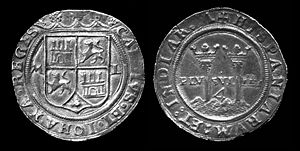 |
|
| Obverse: CAROLVS ET IOHANA, REGES (Charles and Johanna, Monarchs). Depicts the crest of Castile and León. The strike date was determined by the Assayer L. | Reverse: HISPANIARVM ET INDIARVM (Of the Spains [Spanish kingdoms] and the Indies." Depicts the Strait of Gibraltar between the Pillars of Hercules. Center Latin motto is PLVS VLTRA, or "Further Beyond." |
America
During Charles' reign, the territories in New Spain were considerably extended by conquistadores like Hernán Cortés and Francisco Pizarro, who caused the Aztec and Inca empires to fall in little more than a decade. Combined with the Magellan expedition's circumnavigation of the globe in 1522, these successes convinced Charles of his divine mission to become the leader of a Christian world that still perceived a significant threat from Islam. Of course, the conquests also helped solidify Charles' rule by providing the state treasury with enormous amounts of bullion. As the conquistador Bernal Diaz observed: "We came to serve God and our Majesty, ... and also to get rich." [2] In 1550, Charles convened a conference at Valladolid in order to consider the morality of the force used against the indigenous populations of Spanish America.
Holy Roman Empire
| Holy Roman Emperor |
|---|
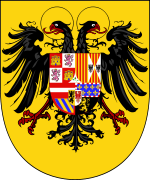 |
After the death of his paternal grandfather, Maximilian, in 1519, he inherited the Habsburg lands in Austria. He was also the natural candidate of the electors to succeed his grandfather. With the help of the wealthy Fugger family, Charles defeated the candidacy of Francis I of France and was elected on 28 June 1519. In 1530, he was crowned Holy Roman Emperor by Pope Clement VII in Bologna, the last Emperor to receive a papal coronation.
Charles was Holy Roman Emperor over the German states, but his real power was limited by the princes. Protestantism gained a strong foothold in Germany, and Charles was determined not to let this happen in the Netherlands. An inquisition was established as early as 1522. In 1550, the death penalty was introduced for all heresy. Political dissent was also firmly controlled, most notably in his place of birth, where Charles, assisted by the Duke of Alba, personally suppressed the Revolt of Ghent in mid-February 1540.[2]
Conflicts with France
Much of Charles's reign was taken up by conflicts with France, which found itself encircled by Charles's empire and still maintained ambitions in Italy. The first war with Charles's great nemesis Francis I of France began in 1521. Charles allied with England and Pope Leo X against the French and the Venetians, and was highly successful, driving the French out of Milan and defeating and capturing Francis at the Battle of Pavia in 1525. To gain his freedom, the French king was forced to cede Burgundy to Charles in the humiliating Treaty of Madrid (1526).
When he was released, however, Francis had the Parliament of Paris denounce the treaty because it had been signed under duress. France then joined the League of Cognac that the Pope had formed with Henry VIII of England, the Venetians, the Florentines, and the Milanese to resist imperial domination of Italy. In the ensuing war, Charles's sack of Rome (1527) and virtual imprisonment of Pope Clement VII in 1527 prevented him from annulling the marriage of Henry VIII of England and Charles's aunt Catherine of Aragon, with important consequences. In other respects, the war was inconclusive. In the Treaty of Cambrai (1529), called the "Ladies' Peace" because it was negotiated between Charles's aunt and Francis's mother, Francis renounced his claims in Italy but retained control of Burgundy.
A third war erupted in 1535, when, following the death of the last Sforza Duke of Milan, Charles installed his own son, Philip, in the duchy, despite Francis's claims on it. This war too was inconclusive. Francis failed to conquer Milan, but succeeded in conquering most of the lands of Charles's ally the Duke of Savoy, including his capital, Turin. A truce at Nice in 1538 on the basis of uti possidetis ended the war, but lasted only a short time. War resumed in 1542, with Francis now allied with Ottoman Sultan Suleiman I and Charles once again allied with Henry VIII. Despite the conquest of Nice by a Franco-Ottoman fleet, the French remained unable to advance into Milan, while a joint Anglo-Imperial invasion of northern France, led by Charles himself, won some successes but was ultimately abandoned, leading to another peace and restoration of the status quo ante in 1544.

A final war erupted with Francis' son and successor, Henry II, in 1551. This war saw early successes by Henry in Lorraine, where he captured Metz, but continued failure of French offensives in Italy. Charles abdicated midway through this conflict, leaving further conduct of the war to his son, Philip II and his brother, Ferdinand I, Holy Roman Emperor.
Conflicts with the Ottoman Empire
Charles fought continually with the Ottoman Empire and its sultan, Suleiman the Magnificent. The expeditions of the Ottoman force along the Mediterranean coast posed a threat to Habsburg lands and Christian monopolies on trade in the Mediterranean. In Central Europe, the Turkish advance was halted at Vienna in 1529. In 1535 Charles won an important victory at Tunis, but in 1536 Francis I of France allied himself with Suleiman against Charles. While Francis was persuaded to sign a peace treaty in 1538, he again allied himself with the Ottomans in 1542. In 1543 Charles allied himself with Henry VIII and forced Francis to sign the Truce of Crepy-en-Laonnois. Charles later signed a humiliating treaty with the Ottomans to gain him some respite from the huge expenses of their war, although it did not end there. However, the Protestant powers in the Holy Roman Empire Diet often voted against money for his Turkish wars, as many Protestants saw the Muslim advance as a counterweight to the Catholic powers. The great Hungarian defeat at the 1526 Battle of Mohács "sent a wave of terror over Europe."[13][14]
Humanism and Reformation

As Holy Roman Emperor, he called Martin Luther to the Diet of Worms in 1521, promising him safe conduct if he would appear. He initially dismissed Luther's idea of reformation as "An argument between monks". He later outlawed Luther and his followers in that same year but was tied up with other concerns and unable to take action against Protestantism.
1524 to 1526 saw the Peasants' Revolt in Germany and in 1531 the formation of the Lutheran Schmalkaldic League. Charles delegated increasing responsibility for Germany to his brother Ferdinand while he concentrated on problems elsewhere.
In 1545, the opening of the Council of Trent began the Counter-Reformation, and Charles won to the Catholic cause some of the princes of the Holy Roman Empire. In 1546, he had the outlawed the Schmalkaldic League (which had occupied the territory of another prince). He drove the League's troops out of southern Germany and at the Battle of Mühlberg defeated John Frederick, Elector of Saxony and imprisoned Philip of Hesse in 1547. At the Augsburg Interim in 1548 he created an interim solution giving certain allowances to Protestants until the Council of Trent would restore unity. However, Protestants mostly resented the Interim and some actively opposed it. Protestant princes, in alliance with Henry II of France, rebelled against Charles in 1552, which caused Charles to retreat to the Netherlands.
Health
Charles suffered from an enlarged lower jaw, a deformity which got considerably worse in later Habsburg generations. He struggled to chew his food properly and consequently experienced bad indigestion for much of his life. As a result, he usually ate alone.[15] He suffered from epilepsy[16] and joint pain, presumed to be gout, according to his 16th century doctors.[17] In his retirement, he was carried around the monastery of St. Yuste in a sedan chair. A ramp was specially constructed to allow him easy access to his rooms.[15]
Abdication and later life
In 1556, Charles abdicated his various titles, giving his Spanish empire (Spain, the Netherlands, Naples and Spain's possessions in the Americas) to his son, Philip II of Spain. His brother Ferdinand, already in possession of the Austrian lands and Roman King succeeded as Emperor elect. Charles retired to the monastery of Yuste in Extremadura, but continued to correspond widely and kept an interest in the situation of the empire. He suffered from severe gout and some scholars think Charles V decided to abdicate after a gout attack in 1552 forced him to postpone an attempt to recapture the city of Metz, where he was later defeated.[18].
Charles died on 21 September 1558 from fatal malaria.[19] Twenty-six years later, his remains were transferred to the Royal Pantheon of The Monastery of San Lorenzo de El Escorial.
Titles
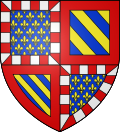 25 September 1506–16 January 1556: Titular Duke of Burgundy as Charles II
25 September 1506–16 January 1556: Titular Duke of Burgundy as Charles II 25 September 1506–16 January 1556: Duke of Brabant as Charles II
25 September 1506–16 January 1556: Duke of Brabant as Charles II 25 September 1506–16 January 1556: Duke of Limburg as Charles II
25 September 1506–16 January 1556: Duke of Limburg as Charles II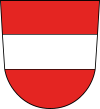 25 September 1506–16 January 1556: Duke of Lothier as Charles II
25 September 1506–16 January 1556: Duke of Lothier as Charles II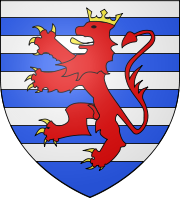 25 September 1506–16 January 1556: Duke of Luxemburg as Charles III
25 September 1506–16 January 1556: Duke of Luxemburg as Charles III 25 September 1506–16 January 1556: Margrave of Namur as Charles II
25 September 1506–16 January 1556: Margrave of Namur as Charles II 25 September 1506–16 January 1556: Count Palatine of Burgundy as Charles II
25 September 1506–16 January 1556: Count Palatine of Burgundy as Charles II 25 September 1506–16 January 1556: Count of Artois as Charles II
25 September 1506–16 January 1556: Count of Artois as Charles II 25 September 1506–16 January 1556: Count of Charolais as Charles II
25 September 1506–16 January 1556: Count of Charolais as Charles II 25 September 1506–16 January 1556: Count of Flanders as Charles III
25 September 1506–16 January 1556: Count of Flanders as Charles III 25 September 1506–16 January 1556: Count of Hainault as Charles II
25 September 1506–16 January 1556: Count of Hainault as Charles II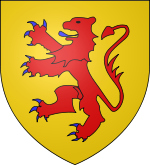 25 September 1506–16 January 1556: Count of Holland as Charles II
25 September 1506–16 January 1556: Count of Holland as Charles II25 September 1506–16 January 1556: Count of Zeeland as Charles II
 12 September 1543–16 January 1556: Duke of Guelders as Charles III
12 September 1543–16 January 1556: Duke of Guelders as Charles III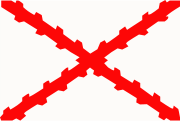 12 September 1543–16 January 1556: Count of Zutphen as Charles II
12 September 1543–16 January 1556: Count of Zutphen as Charles II 14 March 1516–16 January 1556: King of Castile and Leon as Charles I (with Joanna, 14 March 1516 – 12 April 1555)
14 March 1516–16 January 1556: King of Castile and Leon as Charles I (with Joanna, 14 March 1516 – 12 April 1555) 14 March 1516–16 January 1556: King of Aragon and Sicily as Charles I (with Joanna, 14 March 1516 – 12 April 1555)
14 March 1516–16 January 1556: King of Aragon and Sicily as Charles I (with Joanna, 14 March 1516 – 12 April 1555)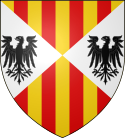 14 March 1516–1554: King of Naples as Charles IV (with Joanna, 14 March 1516 – 12 April 1555)
14 March 1516–1554: King of Naples as Charles IV (with Joanna, 14 March 1516 – 12 April 1555) : 28 June 1519–24 February 1530: King of the Romans as Charles V
: 28 June 1519–24 February 1530: King of the Romans as Charles V : 24 February 1530–16 January 1556: Holy Roman Emperor as Charles V
: 24 February 1530–16 January 1556: Holy Roman Emperor as Charles V 12 January 1519–1521: Archduke of Austria as Charles I
12 January 1519–1521: Archduke of Austria as Charles I
Arms
Charles V in literature and popular culture
There are few figures about whom as many traces have survived half a millennium, in both literature and living minds. Those traces comprise a large number of legends and folk tales that can often be attributed to phantasy, as well as the literary renderings of historical events connected to Charles' life and romantic adventures, his relationship to Flanders, and his abdication.[20]
- In De heerelycke ende vrolycke daeden van Keyser Carel den V, published by Joan de Grieck in 1674, the short stories, anecdotes, citations attributed to the emperor, and legends about his encounters with famous and ordinary people, depict a noble Christian monarch with a perfect cosmopolitan personality and a strong sense of humour. Converesely, in Charles De Coster's masterpiece Thyl Ulenspiegel (1867), Charles V is after his death consigned to Hell as punishment for the acts of the Inquisition under his rule, his punishment being that he would feel the pain of anyone tortured by the Inquisition. De Coster's book also mentions the story on the spectacles in the coat of arms of Oudenaarde, the one about a paysant of Berchem in Het geuzenboek (1979) by Louis Paul Boon, while Abraham Hans (1882–1939) included both tales in De liefdesavonturen van keizer Karel in Vlaanderen.
- Lord Byron's Ode to Napoleon Buonaparte refers to Charles as "The Spaniard".
- Ernst Krenek's opera Karl V (opus 73, 1930) examines the title character's career via flashbacks.
- In the third act of Giuseppe Verdi's opera Ernani, the coronation of Charles as Holy Roman Emperor is presented. Charles (Don Carlo in the opera) prays before the tomb of Charlemagne. With the announcement that he is elected as Carlo Quinto he declares an amnesty including the eponymous bandit Ernani who had followed him there to murder him as a rival for the love of the soprano. The opera, based on the Victor Hugo play, Hernani, portrays Charles as a callous and cynical adventurer whose character is transformed by the election into a responsible and clement ruler.
- In another Verdi opera, Don Carlo, the final scene implies that it is Charles V, now living the last years of his life as a hermit, who rescues his grandson, Don Carlo, from his father Philip II and the Inquisition, by taking Carlo with him to his hermitage at the monastery in Yuste.
- In The Maltese Falcon, the title object is said to have been an intended gift to Charles V.
- A well known Flemish legend about Charles being served a beer at the village of Olen, as well as the emperor's lifelong preference of beer above wine, led to the naming of several beer varieties in his honor. The Haacht Brewery of Boortmeerbeek produces Charles Quint, while the Het Anker Brewery at Mechelen produces Gouden Carolus.[21]
- Carlos V is the name of a popular chocolate bar in Mexico. It's tagline is "El Rey de los Chocolates" or "The King of Chocolates."
- Gouden Carolus Grand Cru of the Emperor (Gouden Carolus Cuvee Van De Keizer) is a beer by Brouwerij Het Anker in Mechelen, Belgium. It is brewed once a year on Charles V's birthday.
Ancestors
| Ancestors of Charles V, Holy Roman Emperor | ||||||||||||||||||||||||||||||||||||||||||||||||||||||||||||||||||||||||||||||||||||||||||||||||||||||||||||||||||||||||||||||||||||||||||||||||||||||||||||||||||||||||||||||||||||||||||||||||||||||||||||||||||||||||||||||||||||||||||||||||||||||||||||||||||||||||||||||||||||||||||||||||||||||||||||||||||||||||||||||||||||||||||||||||||||||||||||||||||||||||||||||||||||||||||||||||||||||||||||||||||||||||||||||||||||||||||||||||||||||||||||||||||||||||||||||||||||||||||||||||||||||||||||||||||||||||||||||||||||||||||||||||||||||||||||||||||
|---|---|---|---|---|---|---|---|---|---|---|---|---|---|---|---|---|---|---|---|---|---|---|---|---|---|---|---|---|---|---|---|---|---|---|---|---|---|---|---|---|---|---|---|---|---|---|---|---|---|---|---|---|---|---|---|---|---|---|---|---|---|---|---|---|---|---|---|---|---|---|---|---|---|---|---|---|---|---|---|---|---|---|---|---|---|---|---|---|---|---|---|---|---|---|---|---|---|---|---|---|---|---|---|---|---|---|---|---|---|---|---|---|---|---|---|---|---|---|---|---|---|---|---|---|---|---|---|---|---|---|---|---|---|---|---|---|---|---|---|---|---|---|---|---|---|---|---|---|---|---|---|---|---|---|---|---|---|---|---|---|---|---|---|---|---|---|---|---|---|---|---|---|---|---|---|---|---|---|---|---|---|---|---|---|---|---|---|---|---|---|---|---|---|---|---|---|---|---|---|---|---|---|---|---|---|---|---|---|---|---|---|---|---|---|---|---|---|---|---|---|---|---|---|---|---|---|---|---|---|---|---|---|---|---|---|---|---|---|---|---|---|---|---|---|---|---|---|---|---|---|---|---|---|---|---|---|---|---|---|---|---|---|---|---|---|---|---|---|---|---|---|---|---|---|---|---|---|---|---|---|---|---|---|---|---|---|---|---|---|---|---|---|---|---|---|---|---|---|---|---|---|---|---|---|---|---|---|---|---|---|---|---|---|---|---|---|---|---|---|---|---|---|---|---|---|---|---|---|---|---|---|---|---|---|---|---|---|---|---|---|---|---|---|---|---|---|---|---|---|---|---|---|---|---|---|---|---|---|---|---|---|---|---|---|---|---|---|---|---|---|---|---|---|---|---|---|---|---|---|---|---|---|---|---|---|---|---|---|---|---|---|---|---|---|---|---|---|---|---|---|---|---|---|---|---|---|---|---|---|---|---|---|---|---|---|---|---|---|---|---|---|---|---|---|---|---|---|---|---|---|---|---|---|---|---|---|---|---|---|---|---|---|---|---|---|---|---|---|---|---|---|---|---|---|---|---|---|---|---|---|---|---|---|---|---|---|---|---|---|---|---|---|---|---|---|---|---|---|---|---|---|---|---|---|---|---|---|---|---|---|---|---|---|---|---|---|---|---|---|---|---|---|---|---|---|---|---|---|---|---|---|---|---|---|---|---|---|---|---|---|---|---|---|---|---|---|---|---|---|---|---|---|---|---|---|---|---|---|---|---|---|---|---|---|---|---|
|
||||||||||||||||||||||||||||||||||||||||||||||||||||||||||||||||||||||||||||||||||||||||||||||||||||||||||||||||||||||||||||||||||||||||||||||||||||||||||||||||||||||||||||||||||||||||||||||||||||||||||||||||||||||||||||||||||||||||||||||||||||||||||||||||||||||||||||||||||||||||||||||||||||||||||||||||||||||||||||||||||||||||||||||||||||||||||||||||||||||||||||||||||||||||||||||||||||||||||||||||||||||||||||||||||||||||||||||||||||||||||||||||||||||||||||||||||||||||||||||||||||||||||||||||||||||||||||||||||||||||||||||||||||||||||||||||||
|
Charles V, Holy Roman Emperor
Born: 24 February 1500 Died: 21 September 1558 |
||
| Regnal titles | ||
|---|---|---|
| Preceded by Philip the Handsome |
Duke of Brabant, Limburg, Lothier and Luxembourg, Count of Artois, Burgundy, Flanders, Hainaut, Holland, Namur and Zeeland after 1549 Ruler of the Seventeen Provinces of the Habsburg Netherlands 1506–1555 |
Succeeded by Philip II |
| Preceded by Ferdinand II |
King of Aragon, Majorca, Valencia, Navarre, Naples and Sicily; Count of Barcelona 1516–1556 with Joanna (1516–1555) |
|
| Preceded by Joanna |
King of Castile and León 1516–1556 with Joanna (1516–1555) |
|
| Preceded by William |
Duke of Guelders, Count of Zutphen 1543–1556 |
|
| Preceded by Maximilian I |
Archduke of Austria Duke of Styria, Carinthia and Carniola Count of Tyrol 1519–1521 |
Succeeded by Ferdinand I[22] |
| King of the Romans ("Emperor-elect" of the Holy Roman Empire) 1519–1530 |
||
| King of Italy 1530–1556 |
||
| Holy Roman Emperor 1530–1556 |
||
| Spanish royalty | ||
| Preceded by Infanta Joanna |
Prince of Asturias 1504–1516 |
Succeeded by Infante Philip |
| Titles in pretence | ||
| Preceded by Ferdinand II of Aragon |
— TITULAR — Byzantine Emperor Reason for succession failure: Ottoman conquest of the Byzantine Empire |
Succeeded by Philip II of Spain |
| Preceded by Philip I of Castile |
— TITULAR — Duke of Burgundy 1506–1555 |
|
Notes
- ↑ Dennis Bratcher (ed.). The Edict of Worms (1521).
- ↑ 2.0 2.1 2.2 2.3 Kamen, Henry (2005). Spain, 1469–1714: a society of conflict (3rd ed.). Harlow, United Kingdom: Pearson Education. ISBN 0-582-78464-6. http://www.pearsoned.co.uk.
- ↑ Seidel, Michael; Andrews, Robert; Biggs, Mary (1996). The Columbia World of Quotations. New York: Columbia University Press. ISBN 0-231-10518-5. http://www.bartleby.com/66/95/32695.html. Quotation number 32695.
- ↑ Cortes de los antiguos reinos de León y de Castilla; Manuel Colmeiro (1883), chapter XXIII
- ↑ Estudio documental de la moneda castellana de Carlos I fabricada en los Países Bajos (1517); José María de Francisco Olmos, Revista General de Información y Documentación 2003, vol 13, núm.2 (Universidad complutense de Madrid)], page 137
- ↑ Estudio documental de la moneda castellana de Juana la Loca fabricada en los Países Bajos (1505-1506); José María de Francisco Olmos, Revista General de Información y Documentación 2002, vol 12, núm.2 (Universidad complutense de Madrid), page 299
- ↑ Estudio documental de la moneda castellana de Carlos I fabricada en los Países Bajos (1517); José María de Francisco Olmos, page 138
- ↑ Estudio documental de la moneda castellana de Carlos I fabricada en los Países Bajos (1517); José María de Francisco Olmos, pp. 139-140
- ↑ Encyclopædia Britannica, 1911 edition.
- ↑ Cortes de los antiguos reinos de León y de Castilla; Manuel Colmeiro (1883), chapter XXIV]
- ↑ Historia general de España; Modesto Lafuente (1861), pp. 51-52.
- ↑ Fueros, observancias y actos de corte del Reino de Aragón; Santiago Penén y Debesa, Pascual Savall y Dronda, Miguel Clemente (1866), page 64
- ↑ Quoted from: Bryan W. Ball. A Great Expectation. Brill Publishers, 1975. ISBN 9004043152. Page 142.
- ↑ Life Span of Suleiman The Magnificent, 1494-1566
- ↑ 15.0 15.1 Dr. Martyn Rady, University of London, lecture 2000.
- ↑ German Epilepsy Museum Kork
- ↑ "Tests confirm old emperor's gout diagnosis." The Record. 4 August 2006, Nation.
- ↑ Ordi J, Alonso PL, de Zulueta J, et al (August 2006). "The severe gout of Holy Roman Emperor Charles V". N. Engl. J. Med. 355 (5): 516–20. doi:. PMID 16885558.
- ↑ de Zulueta J (June 2007). "The cause of death of Emperor Charles V". Parassitologia 49 (1-2): 107–9. PMID 18412053.
- ↑ Heymans, Frans (last update 2007-06-04). "Keizer Karel in de literatuur" (in Dutch). Overzichten. Literair Gent, an initiative by the Municipal Public Library of Ghent and 'Gent Cultuurstad'. Retrieved on 2007-07-20.
- ↑ "Charles V (describing the tale of the "pot van Olen")". Global Beer Network, Santa Barbara, CA, U.S.A.. Retrieved on 2007-07-18.
* "Wisselbieren (section 'Anker Bok')". Kafee 't BuitenBeentje, Tilburg, The Netherlands. Retrieved on 2007-07-18. "Keizer Karel, die te Mechelen opgevoed werd door zijn tante Margaretha van Oostenrijk, was vol waardering voor het Mechelse gerstenat. Toen hij na zijn troonsafstand in Spanje woonde, liet hij nog regelmatig Mechels bier naar Spanje vervoeren omdat "het bloed van de druiventros hem minder goed bekwam dan de dochter van de korenaar". (Emperor Charles, who was raised at Mechelen by his aunt Margarete of Austria, fully praised the Mechlinian barley-bree. While he lived in Spain after his abdication of the throne, he still had Mechlinian beer transported regularly to Spain because "the blood of the grape bunch became him not as well as the daughter of the corn ear".)"
* "Charles Quint Golden Blond". Haacht Brewery. Retrieved on 2007-07-18.
* "Charles Quint Ruby Red". Haacht Brewery. Retrieved on 2007-07-18.
* "Beers by Het Anker (click on the beer names)". Brewery Het Anker. Retrieved on 2007-07-18. Also an alternative name
* "Places to visit — Mechelen - Brussels - Ghent". Einscafé (magazine, newsletter). The EINS (European Information Network Services) organisation. Retrieved on 2007-07-18. "The procession was last seen in 1988 but this year it is being brought forward by exception to mark Charles V Year. Mechelse Ommegang : 29 August, 3 and 10 September 2000 in Mechelen (...) one of nine cultural cities of Europe in the year 2000. Brussels more than merits this title during Charles V year." - ↑ Ferdinand used the title of a King of Italy though he was never crowned as such.
Bibliography
- (German) Norbert Conrads: Die Abdankung Kaiser Karls V. Abschiedsvorlesung, Universität Stuttgart, 2003 (text)
- (German) Stephan Diller, Joachim Andraschke, Martin Brecht: Kaiser Karl V. und seine Zeit. Ausstellungskatalog. Universitäts-Verlag, Bamberg 2000, ISBN 3-933463-06-8
- (German) Alfred Kohler: Karl V. 1500–1558. Eine Biographie. C. H. Beck, München 2001, ISBN 3-406-45359-7
- (German) Alfred Kohler: Quellen zur Geschichte Karls V. Wissenschaftliche Buchgesellschaft, Darmstadt 1990, ISBN 3-534-04820-2
- (German) Alfred Kohler, Barbara Haider. Christine Ortner (Hrsg): Karl V. 1500–1558. Neue Perspektiven seiner Herrschaft in Europa und Übersee. Verlag der Österreichischen Akademie der Wissenschaften, Wien 2002, ISBN 3-7001-3054-6
- (German) Ernst Schulin: Kaiser Karl V. Geschichte eines übergroßen Wirkungsbereichs. Kohlhammer, Stuttgart 1999, ISBN 3-17-015695-0
- (German) Ferdinant Seibt: Karl V. Goldmann, München 1999, ISBN 3-442-75511-5
- (German) Manuel Fernández Álvarez: Imperator mundi: Karl V. – Kaiser des Heiligen Römischen Reiches Deutscher Nation.. Stuttgart 1977, ISBN 3763011781
|
||||||||||
|
||||||||||||||||||||||||||||
|
||||||||||||||||||||||||||
| Persondata | |
|---|---|
| NAME | Charles V, Holy Roman Emperor |
| ALTERNATIVE NAMES | Carlos V, Carlos I, Charles I of Spain, Charles Quint |
| SHORT DESCRIPTION | Ruler of the Burgundian territories, King of Castile, King of Aragon, King of Naples, King of Sicily, Archduke of Austria, King of the Romans, or German King, and Holy Roman Emperor |
| DATE OF BIRTH | 24 February 1500 |
| PLACE OF BIRTH | Ghent |
| DATE OF DEATH | 21 September 1558 |
| PLACE OF DEATH | Yuste in Extremadura |


